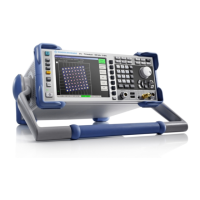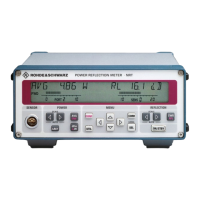R&S FSH Cable Measurements
1309.6275.12 4.67 E-2
To perform distance-to-fault measurements, the R&S FSH needs to “know” the type of cable and its
approximate length.
The cable type must be known to determine the speed of propagation and so the distance to any fault
along the cable. The attenuation of the cable must be known to determine the size of the fault correctly.
The R&S FSH automatically sets the span according to the approximate length of the cable.
Cable selection
Frequency-dependent cable models can be generated with the supplied R&S FSH4View Windows
software package and loaded into the R&S FSH. The procedure is described in the R&S FSH4View
manual. The R&S FSH can store up to 100 different cable types in its internal memory. The total
number of storable limit lines, transducer factors and cable models is 100. If transducer factors, channel
tables, limit lines or data sets are stored simultaneously, the maximum number of cable models
decreases correspondingly (see "Saving and Loading Instrument Settings and Measurement Results" in
this chapter).
If the distance to a cable fault is to be located precisely, it is essential to use the appropriate cable
model. If not, the R&S FSH will not be able to correctly determine the distance of the fault from the
measurement plane and the magnitude of the reflection at the fault.
Selecting a cable model from a predefined list:
Press the CABLE MODEL softkey.
The R&S FSH displays the list of cable models.
Using the rotary knob or the cursor keys, select the
appropriate cable model.
Using the softkey, activate the cable model you
have selected.
The R&S FSH returns to the DTF measurement
function and shows the cable used for the
measurement in the upper area of the display.

